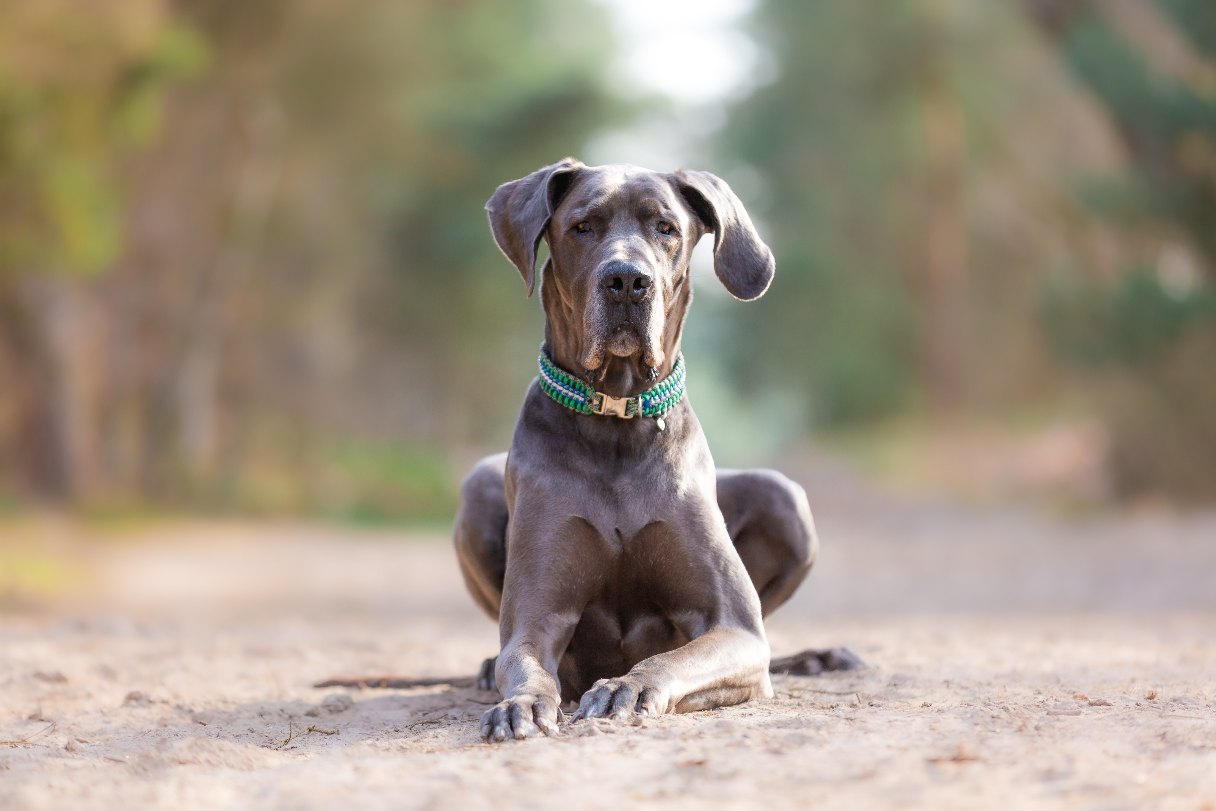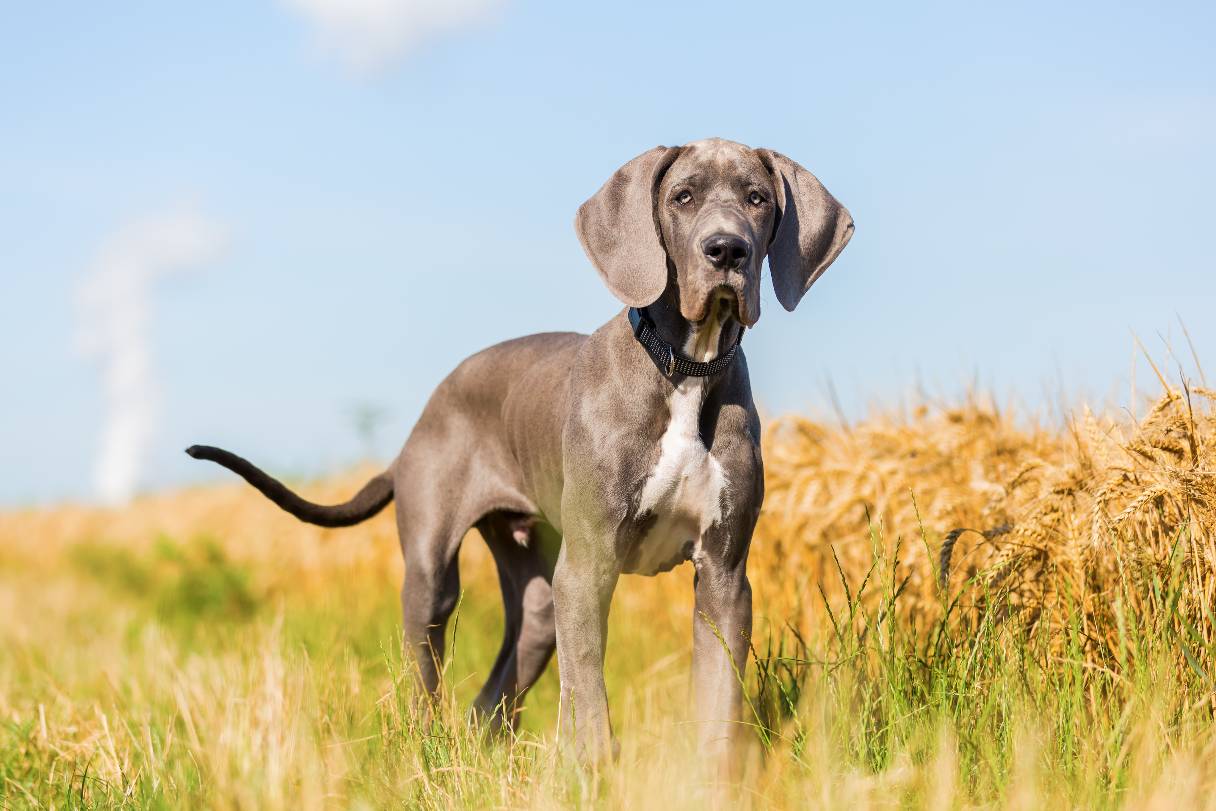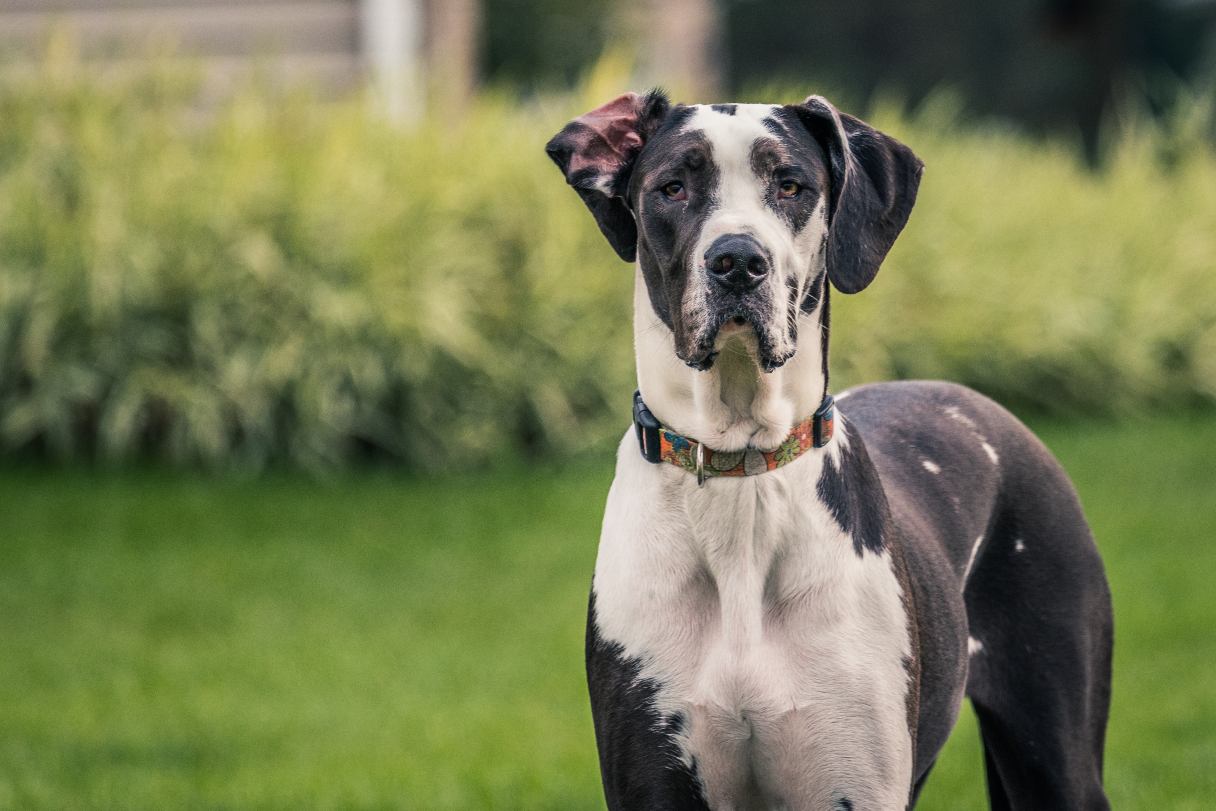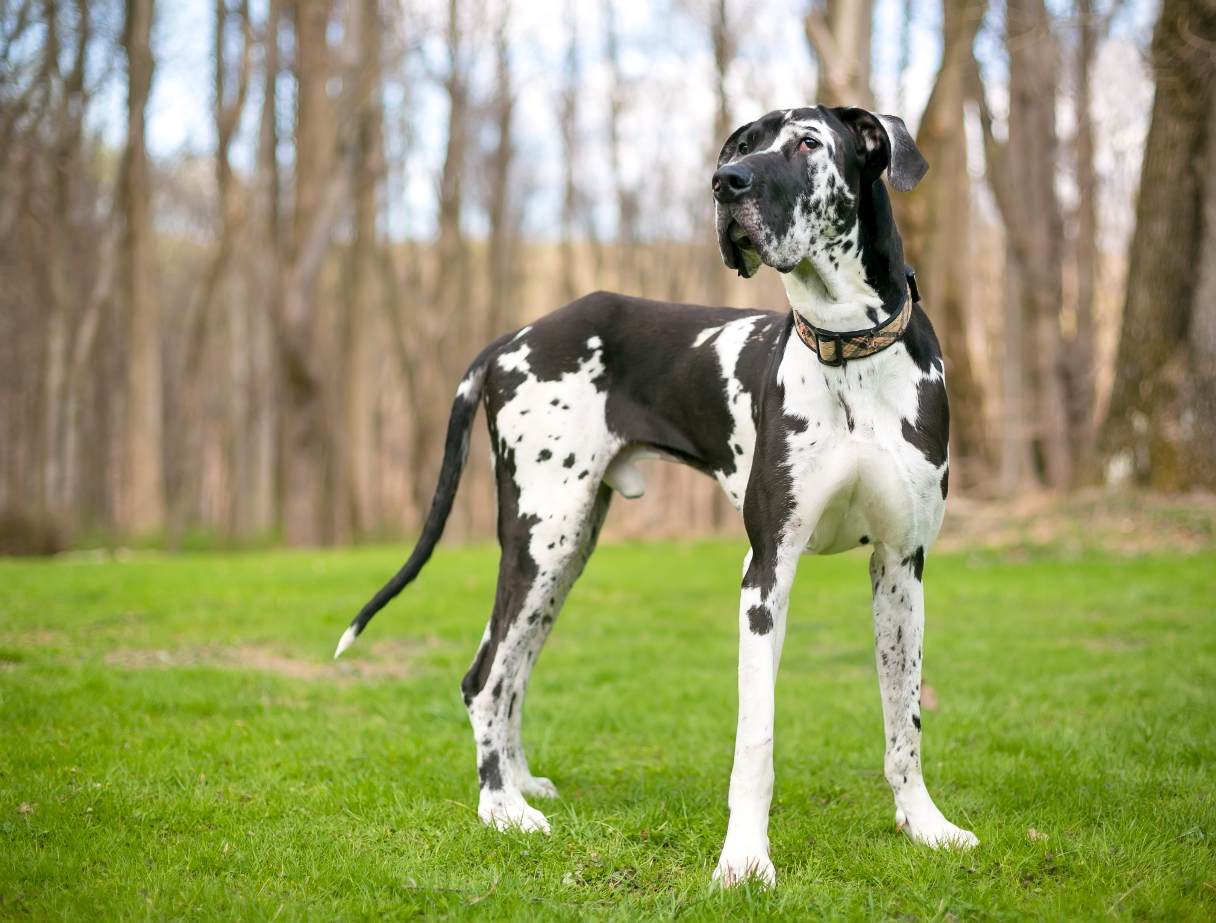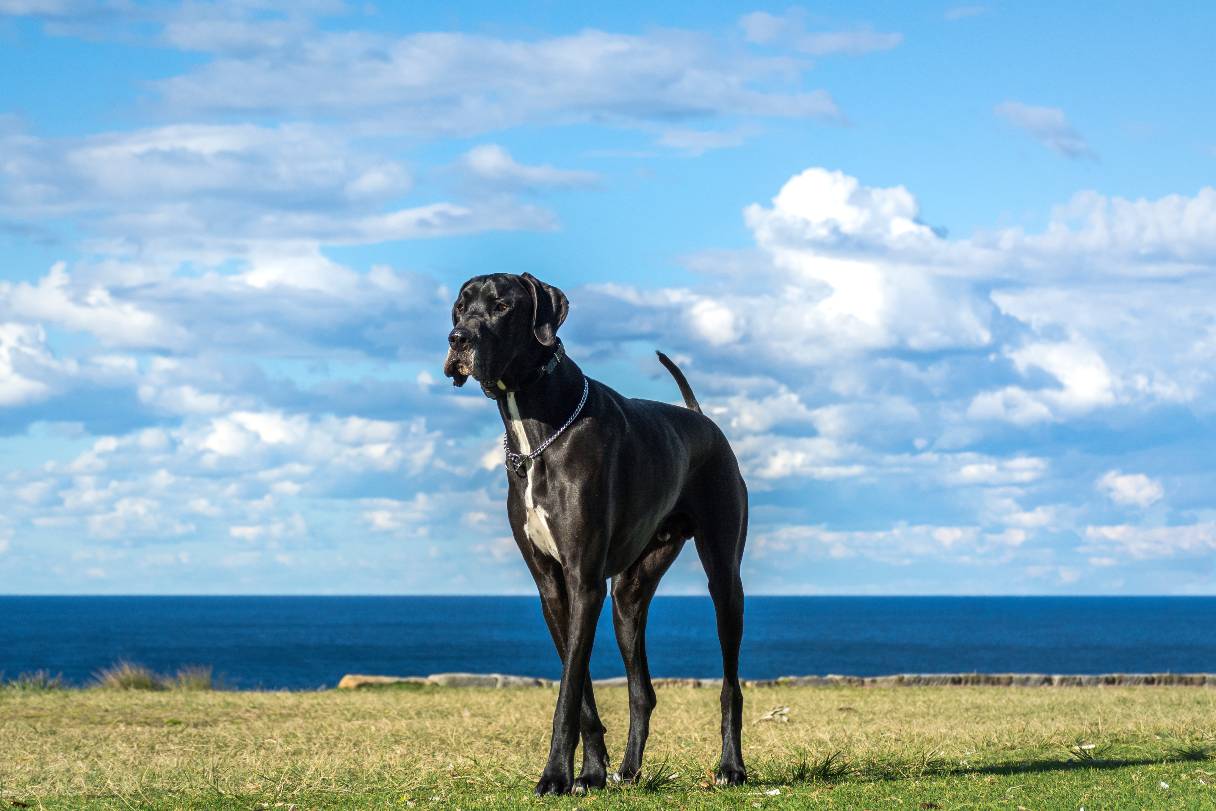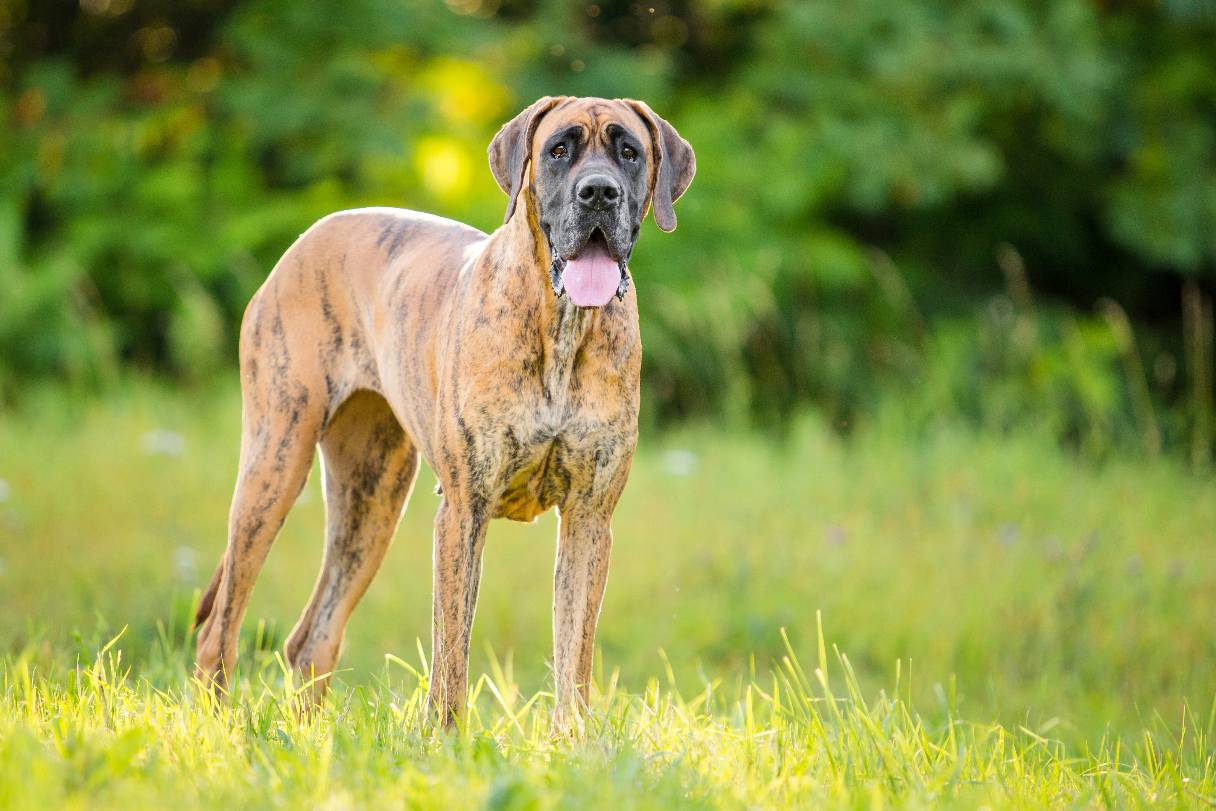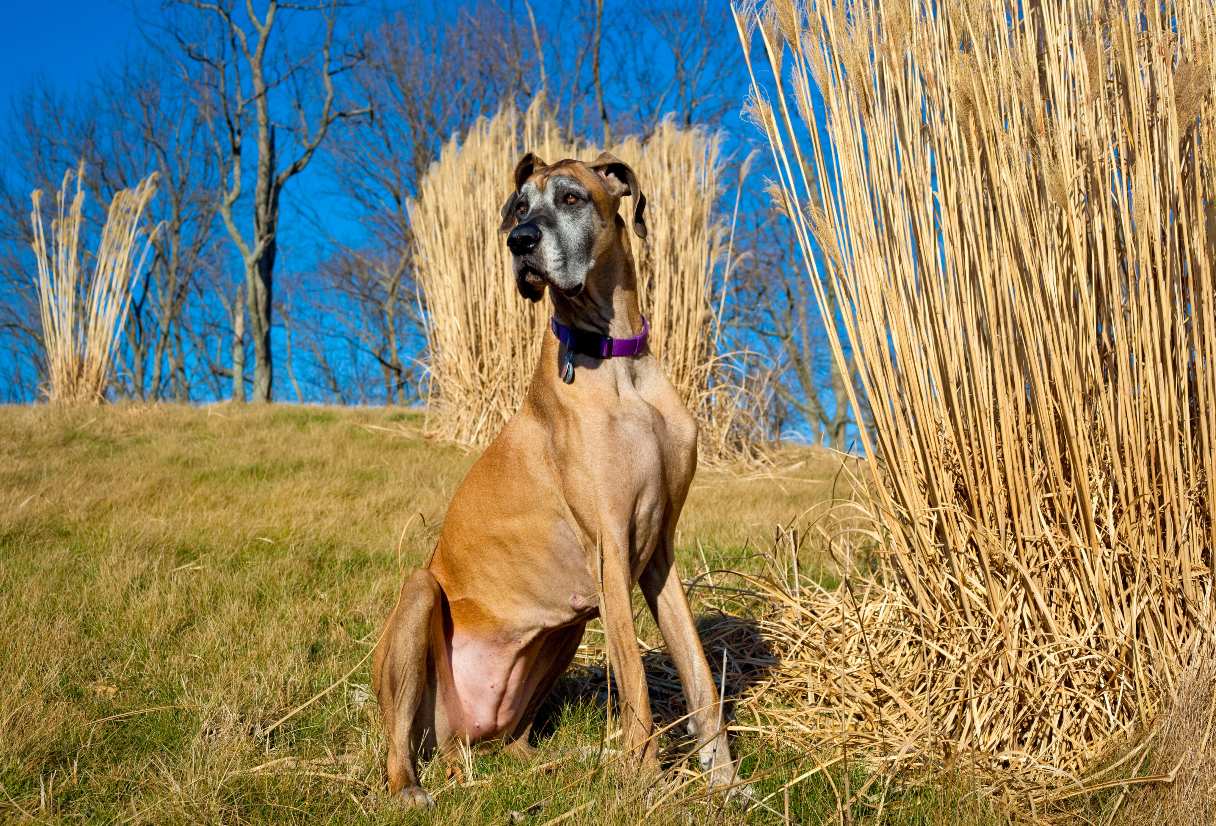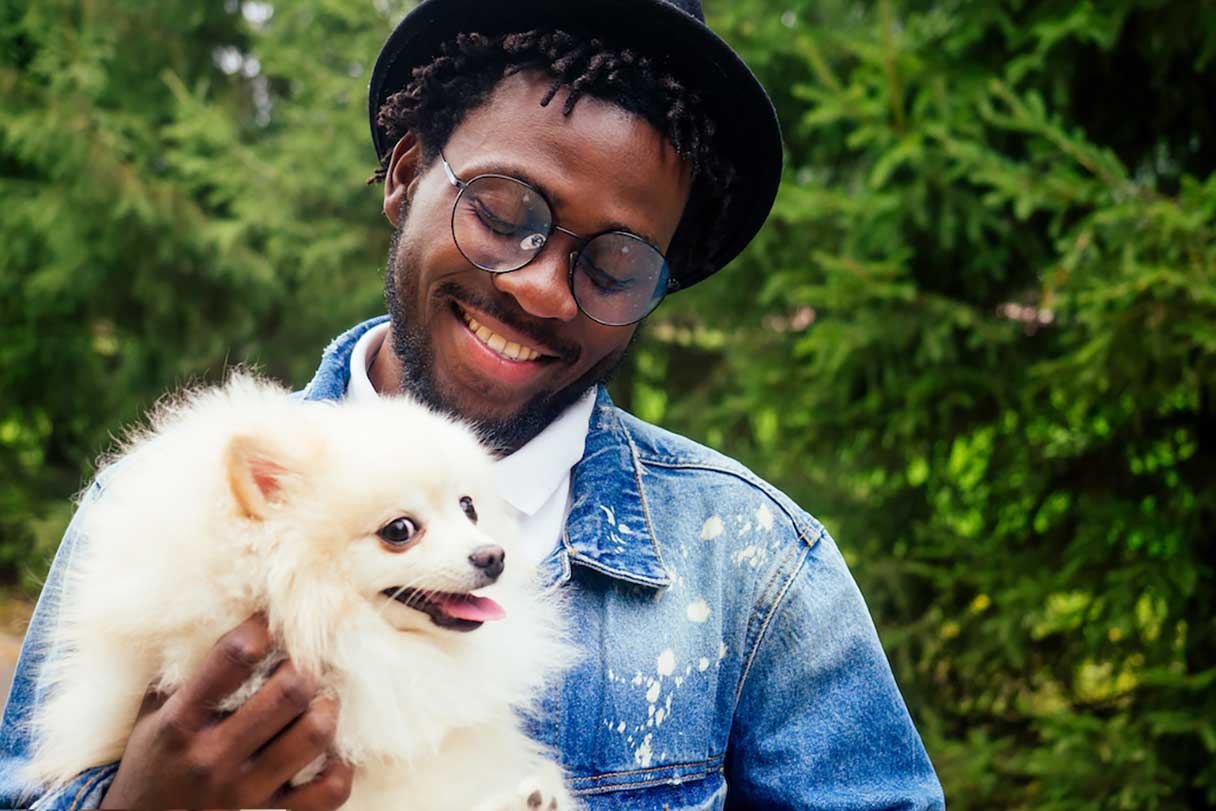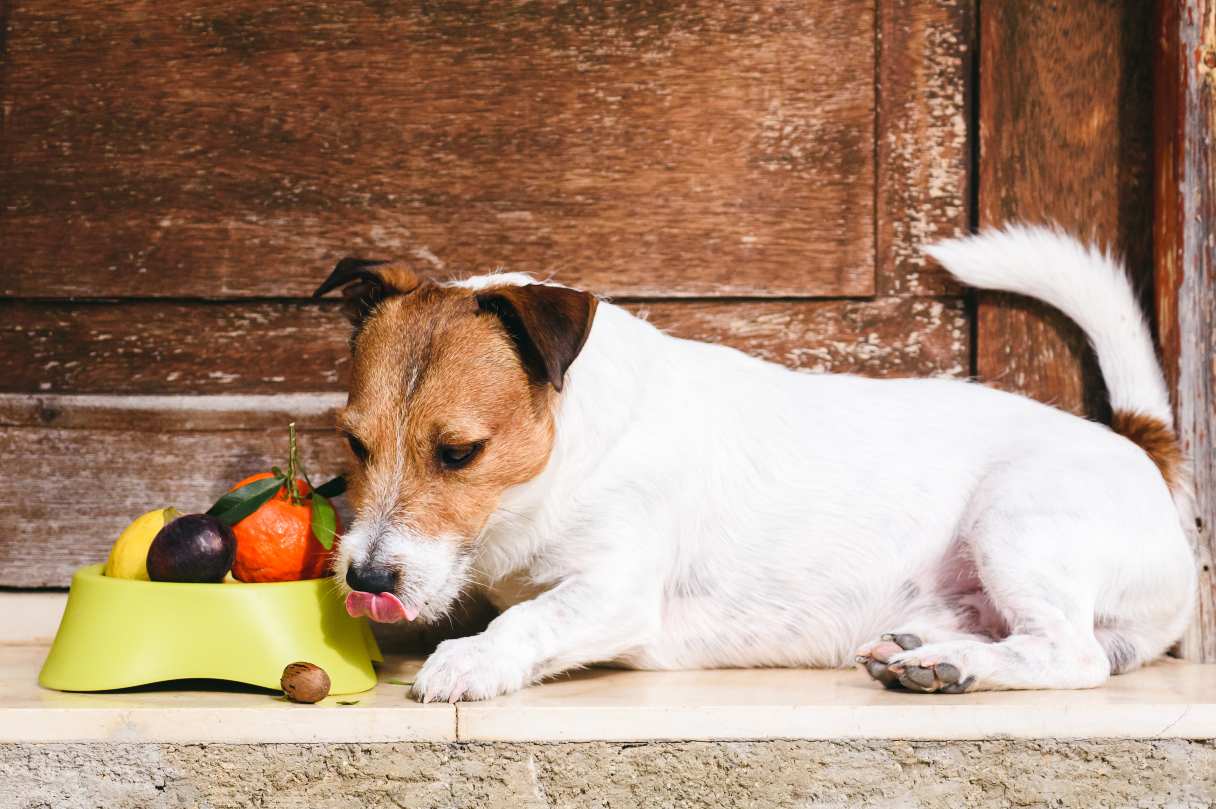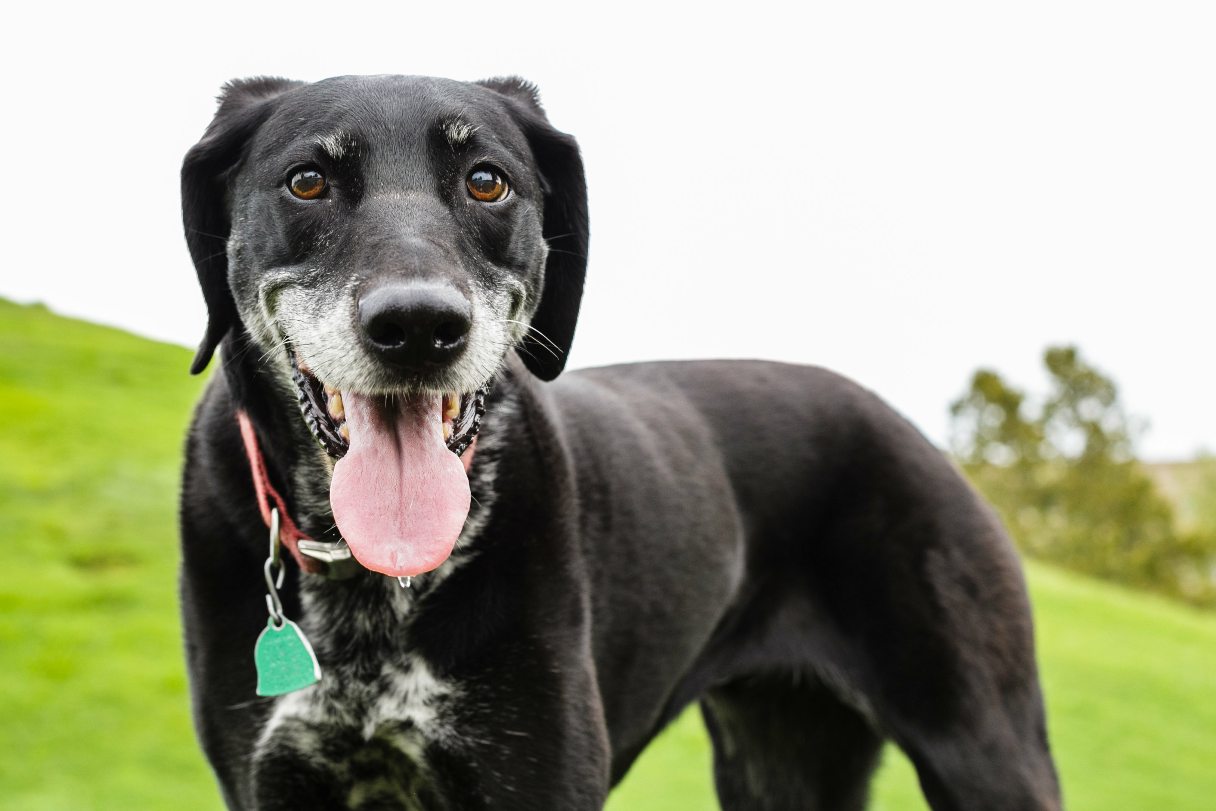The Great Dane is truly the gentlest of giants. Loving, joyful and often silly, this tallest of all dogs nevertheless possesses a noble bearing and the courage and alertness to be an effective family protector.1
Discover more about the Great Dane’s temperament, health and maintenance needs and what it’s like to live with and train these titanic sweetie pies.
About the Great Dane
Not a lot is known about the origins of the Great Dane. One thing that is certain is that Danes are not, in fact, Danish. They originated in Germany.1
Descended from giant mastiffs, these dogs were used in the 16th century as boarhounds in their native Germany. Somewhere along the way, the French — for reasons known only to them — took to calling them "Grand Danois," which translates to Great Dane in English. The name stuck in the English-speaking world, but in their country of origin, where they were declared the national dog breed in 1876, they’re known simply as the "Deutsche Dogge" — that is, the German dog.2
Sometime in the late 19th century, after the first breed clubs were established, breeders crossed the larger and more brutish Dane of the time with the greyhound, creating a more elegant and streamlined look for the breed that has earned it the nickname “Apollo of dogs.” Breeders have also worked diligently over the last century to breed out aggression and develop a dog with a stable, friendly temperament.2
Great Dane Appearance
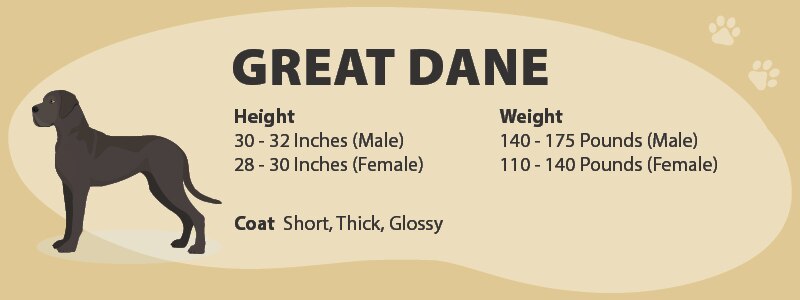
Great Danes tower above all other dog breeds, with males reaching 30 to 32 inches at the shoulder and weighing 140 to 175 pounds.1 Females are smaller, reaching 28 to 30 inches in height and weighing 110 to 140 pounds.1 Females also tend to have slightly more delicate and feminine facial features than their boxier male counterparts.3
For such large dogs, Danes are rather streamlined, strong and muscular without any bulkiness. They have a broad, deep chest that tucks up into a thin waist, a long neck that extends up from a long, straight back and an undocked, tapered tail that is long and carried high. The head and muzzle are rectangular when viewed both from the front and the side, with a very slight stop between the top of the head and the beginning of the muzzle.3
Danes naturally have medium-sized ears that are set high on the head and fold down along the cheek.3 Traditionally, the ears have been cropped to stand erect.3 But the American Veterinary Medical Association discourages the practice of ear cropping for strictly cosmetic purposes.4 The official breed standard allows for either cropped or natural ears.3
The Dane’s short, thick and glossy coat comes in a variety of colors and patterns. They may be solid black, blue or fawn, or they may be merle or brindled. They may also be white with black patches or markings. Danes with brindled or fawn coats may also have a black mask on the muzzle and around the eyes.3
Great Dane Temperament
The breed standard describes the Great Dane temperament as “spirited, courageous, always friendly, dependable and never timid or aggressive.”3 Danes are highly social, extremely loving with their people and open to making new friends, but they’re not friendly to a fault.1 These are also highly intelligent and alert dogs who are good at taking their cues from you whether to view someone as a threat and go into protection mode.1
Danes have a truly playful streak that makes them a joy to be around. But with their size and strength, they need obedience training and lots of socialization from a young age to teach them what’s appropriate and help them rein in those playful impulses so nobody gets hurt.1
Thankfully, their intelligence is matched by an eagerness to please, which makes them easy to train, although they can be a bit willful at times. Firm, consistent training with lots of rewards can usually overcome any stubbornness and mold them into well-behaved, gentle giants.1
Living With a Great Dane
Great Danes are wonderful dogs, but they may not be right for everyone. Here’s a snapshot of what it’s like to live with and take care of these big, sweet goofballs.
Who they’re best for
With their size, a Great Dane needs an owner who's physically strong enough to avoid getting pushed, pulled or knocked down and who can provide consistent training to teach and reinforce good manners. That said, Danes have a gentle nature, and it’s not hard to teach them how to be gentle with their humans.5
They can make excellent family dogs and do well with children and other pets.6 However, they need to be taught as puppies that small children are not other puppies and must be treated with care, and the same goes for small pets.6 Lots of socialization from early puppyhood will help them learn not to play too rough before they’re big enough to do real damage.7
Danes are highly affectionate dogs who need lots of love and affection in return.7 They need to be part of the family, and care will need to be taken to prevent them from developing separation anxiety.8 Crate training from an early age — and forming positive associations with being in their crate — will help them cope with being left alone when necessary.9 But these are not dogs that can be kept outside or that will keep to themselves and stay out of the way — they want to be with you.
Living space
Great Danes can do well in either the country or the city. They do best in a home with a yard that’s secured with a tall, sturdy fence. Otherwise, they should be kept on a leash at all times when outdoors, lest their hunting instincts cause them to wander off chasing a scent, heedless of any danger they might wander into.1
Due to their size, Danes probably aren’t well-suited to apartment living, unless you have lots of space.
Exercise and activity
Danes aren’t overly energetic, but they do need a moderate amount of exercise to stay fit and happy. As highly intelligent dogs, they also need a good deal of mental enrichment to keep from getting bored. Two or three energetic walks around the block throughout the day, combined with playtime, is usually enough.1
These are athletic dogs who can eventually make excellent jogging or hiking companions, and they also tend to love dog sports like agility and flyball. However, Danes don’t finish growing until they’re two years old. Until their growth plates close, you should refrain from letting them run or jump to avoid damage to their joints.1
When they’re finished with exercise and ready to relax, it’s a good idea to provide them with a durable orthopedic dog bed that’s elevated for easy access and that can avoid putting pressure on their joints.
Grooming
Relatively speaking, the Dane’s short, smooth coat is not prone to heavy shedding. But that coat is stretched over a big surface, and what Danes do shed can add up. Brushing at least once a week — and daily during heavier shedding seasons — will help keep your Dane’s coat shiny and keep the hair under control.1
With Danes, drooling is a bigger issue than shedding.1 You’ll want to keep a drool rag handy to mop up after them.
Danes only need baths when they become dirty or smelly.1 It’s important to keep their nails trimmed to avoid pain and foot injuries from all the weight they carry.1 Ears should be cleaned and checked for signs of infection regularly, and brushing their teeth at least a few times a week will help prevent dental disease.
Danes are also prone to canine acne. While the exact cause is unknown, using metal bowls instead of plastic for food and water may help decrease breakouts.10
Great Dane Health and Life Expectancy

Great Danes are, sadly, one of the shortest-lived dog breeds, with an average life expectancy of seven to 10 years.1 But good breeding, regular veterinary checkups, good nutrition and maintaining your Dane at a healthy weight can all help to extend their lifespan and increase their quality of life.
Danes do best on high-quality dog food that matches their life stage and meets nutritional standards developed by the Association of American Feed Control Officials (AAFCO).1 They should be fed large breed dog and puppy food that is formulated to support large and rapidly growing bones.11
It’s important to keep Danes at a healthy weight to help prevent joint problems and other health issues as they age. Avoid feeding them table scraps, and measure out their food instead of free feeding. Danes also have the highest likelihood of bloat, a potentially deadly condition that can be brought on by too much gas. Feeding them multiple small meals throughout the day, rather than one big one, can help lower the chances. As for treats, consider healthy, dog-safe fruits and veggies in place of calorie-laden commercial treats for training and rewards.1
Although ethical breeders do their best to screen out genetic diseases, Great Danes are prone to a number of health issues that can impact both length and quality of life. Some of them can be serious and quite costly to treat or manage. Here are some health issues that are common to Great Danes:
Bloat
Gastric dilatation and volvulus (GDV), also known as bloat, is cited as the number one killer of Great Danes.1 It occurs when gas buildup causes the stomach to bloat, twist and cut off circulation.12
All large, deep-chested dogs are predisposed to this condition, but Danes are disproportionately affected. Symptoms include a bloated abdomen and dry heaving, which are signs that you should get your Dane to an emergency vet immediately. Fortunately, you can ask your vet about a simple surgical procedure that can drastically lower the chances of bloat occurring.12
Cancer
All dogs have a chance of getting cancer, especially as they get older. But after bloat, cancer is a leading cause of death in Great Danes. They’re especially prone to osteosarcoma, or bone cancer, and lymphoma, which is a cancer that affects the lymph nodes and can occur throughout the body.13
You should discuss the likelihood of cancer with your vet when it comes to making decisions about spaying or neutering, and be sure to keep up with regular vet checkups and report any strange lumps or bumps or changes in health or behavior to your vet ASAP.
Dilated cardiomyopathy
Dilated cardiomyopathy is the most common cause of heart failure in Great Danes. It occurs when the wall of the left ventricle of the heart grows progressively thinner. This weakens the heart and makes it have to work harder to pump blood throughout the body. Dogs with this condition may or may not have a detectable heart murmur or arrhythmia. It can usually be managed with a combination of medications, special diet and lifestyle changes.14
Eye problems
While not super common in the breed, Great Danes can be prone to certain eye health conditions.13 These include:
-
Cataracts. A cataract is an opaque film that develops over the surface of the eye and obscures vision. Depending on the severity, cataracts can cause partial or total blindness. But in dogs who are good candidates for surgery, they can usually be removed.15
-
Ectropion and entropion. Ectropion is an eyelid malformation that causes the eyelid to turn inside out.16 Similarly, entropion causes the lid to fold inward.17 Either case can cause painful irritation, as well as corneal ulcers (sores on the eyeball) that can lead to permanent damage.16
Hip dysplasia
Hip dysplasia is a genetic abnormality that prevents the ball of the hip joint from fitting properly into the socket. This is a painful condition that also causes wear and tear on the joints. Untreated, this eventually leads to arthritis and mobility issues. Mild to moderate cases can be managed with lifestyle adjustments and pain medications, but severe cases may need to be corrected with surgery.18
Hypertrophic osteodystrophy (HOD)
Hypertrophic osteodystrophy (HOD) is a developmental disease that sometimes affects Great Dane puppies from 2 to 8 months of age. It causes the neck portion of the long bones to become inflamed, resulting in painful swelling, limping and mobility issues. Severe cases can also cause dangerously high fever, appetite loss and weight loss. It’s usually treated with either nonsteroidal anti-inflammatory drugs (NSAIDs) or corticosteroids, as well as supportive care. Mild cases usually correct on their own, but severe cases may result in bone deformities that require surgery to correct.19
Hypothyroidism
Hypothyroidism occurs when the thyroid gland doesn’t produce enough thyroid hormone to properly regulate the metabolism. This causes it to be sluggish, which in turn causes a wide range of other health issues. Obvious signs include fatigue, a dull or patchy coat and unexplained weight gain. The good news is that it’s easily managed with thyroid replacement medication.20
Wobbler syndrome
Named for the way affected dogs tend to wobble when they walk, wobbler syndrome is caused by spinal compression that causes lack of coordination and stiffness in the limbs. Milder cases can often be treated with a combination of corticosteroids and rest, but more advanced cases may require surgery and lengthy physical therapy to correct.21
How Much Does It Cost to Buy or Adopt a Great Dane?
Good breeding is always important, but when it comes to finding a Great Dane with optimal chances of good health and an ideal temperament, it’s vital to research and find a responsible breeder. You can find ethical breeders via the AKC marketplace website who sell Great Dane puppies from championship bloodlines for prices ranging from $1,000 to $3,500 and up.22
Great Danes and Dane mixes of all ages may be available to adopt from pet shelters and Great Dane rescue organizations. You can find information on Great Dane rescues across the U.S. on the Great Dane Club of America website. Adoption fees at shelters and rescues will vary based on where you adopt, but the Mid-Atlantic Great Dane Rescue League charges either $325 or $450, depending on the age of the dog or pup.23
Frequently Asked Questions About Great Danes
Still have questions about Great Danes? Here are answers to some commonly asked questions about this dog breed.
CareCredit Credit Card Financing for Dogs
Taking good care of your pet's well-being from nose to tail is essential. Make sure to stay up to date on their regular checkups at the vet to help keep your pet happy and healthy for a lifetime of love. You can use your CareCredit credit card for pet care throughout the year for routine veterinary services as well as emergencies and surgeries.* Use our Acceptance Locator to find a veterinarian near you that accepts CareCredit.
CareCredit is there for you and your pet every step of the way; continue your wellness journey by downloading the CareCredit Mobile App to manage your account, find a provider on the go and easily access the Well U blog for more great articles, podcasts and videos.
In addition to pet care, you can also use your CareCredit credit card for dentistry, cosmetic, vision, hearing, health systems, dermatology, pharmacy purchases, spa treatments and so much more within the CareCredit network. How will you invest in your health and wellness next?
Author Bio
Jean Marie Bauhaus is a freelance writer and novelist who has been writing pet content since 2013. Her work has appeared on Forbes.com, Hill's Pet, Chewy, AKC.org and more.



